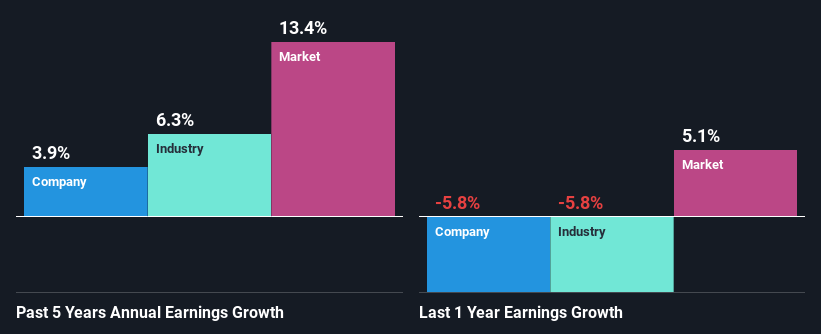Can Mixed Fundamentals Have A Negative Impact on Volcano Berhad (KLSE:VOLCANO) Current Share Price Momentum?
Volcano Berhad (KLSE:VOLCANO) has had a great run on the share market with its stock up by a significant 17% over the last month. However, we wonder if the company's inconsistent financials would have any adverse impact on the current share price momentum. In this article, we decided to focus on Volcano Berhad's ROE.
Return on equity or ROE is a key measure used to assess how efficiently a company's management is utilizing the company's capital. In short, ROE shows the profit each dollar generates with respect to its shareholder investments.
View our latest analysis for Volcano Berhad
How Do You Calculate Return On Equity?
Return on equity can be calculated by using the formula:
Return on Equity = Net Profit (from continuing operations) ÷ Shareholders' Equity
So, based on the above formula, the ROE for Volcano Berhad is:
6.0% = RM6.2m ÷ RM103m (Based on the trailing twelve months to March 2024).
The 'return' is the amount earned after tax over the last twelve months. So, this means that for every MYR1 of its shareholder's investments, the company generates a profit of MYR0.06.
What Is The Relationship Between ROE And Earnings Growth?
We have already established that ROE serves as an efficient profit-generating gauge for a company's future earnings. Depending on how much of these profits the company reinvests or "retains", and how effectively it does so, we are then able to assess a company’s earnings growth potential. Assuming everything else remains unchanged, the higher the ROE and profit retention, the higher the growth rate of a company compared to companies that don't necessarily bear these characteristics.
A Side By Side comparison of Volcano Berhad's Earnings Growth And 6.0% ROE
When you first look at it, Volcano Berhad's ROE doesn't look that attractive. Yet, a closer study shows that the company's ROE is similar to the industry average of 7.5%. On the other hand, Volcano Berhad reported a fairly low 3.9% net income growth over the past five years. Bear in mind, the company's ROE is not very high . Hence, this does provide some context to low earnings growth seen by the company.
As a next step, we compared Volcano Berhad's net income growth with the industry and were disappointed to see that the company's growth is lower than the industry average growth of 6.3% in the same period.
The basis for attaching value to a company is, to a great extent, tied to its earnings growth. The investor should try to establish if the expected growth or decline in earnings, whichever the case may be, is priced in. This then helps them determine if the stock is placed for a bright or bleak future. If you're wondering about Volcano Berhad's's valuation, check out this gauge of its price-to-earnings ratio, as compared to its industry.
Is Volcano Berhad Efficiently Re-investing Its Profits?
While Volcano Berhad has a decent three-year median payout ratio of 30% (or a retention ratio of 70%), it has seen very little growth in earnings. So there could be some other explanation in that regard. For instance, the company's business may be deteriorating.
Additionally, Volcano Berhad started paying a dividend only recently. So it looks like the management must have perceived that shareholders favor dividends over earnings growth.
Conclusion
On the whole, we feel that the performance shown by Volcano Berhad can be open to many interpretations. While the company does have a high rate of profit retention, its low rate of return is probably hampering its earnings growth. Wrapping up, we would proceed with caution with this company and one way of doing that would be to look at the risk profile of the business. You can see the 2 risks we have identified for Volcano Berhad by visiting our risks dashboard for free on our platform here.
Have feedback on this article? Concerned about the content? Get in touch with us directly. Alternatively, email editorial-team (at) simplywallst.com.
This article by Simply Wall St is general in nature. We provide commentary based on historical data and analyst forecasts only using an unbiased methodology and our articles are not intended to be financial advice. It does not constitute a recommendation to buy or sell any stock, and does not take account of your objectives, or your financial situation. We aim to bring you long-term focused analysis driven by fundamental data. Note that our analysis may not factor in the latest price-sensitive company announcements or qualitative material. Simply Wall St has no position in any stocks mentioned.

 Yahoo Finance
Yahoo Finance 
